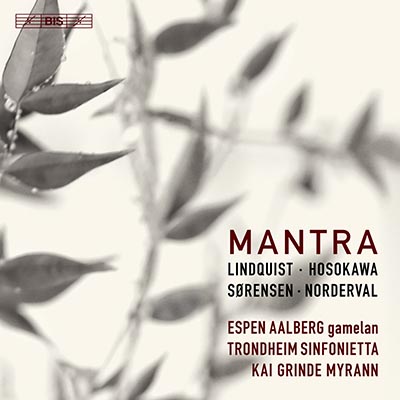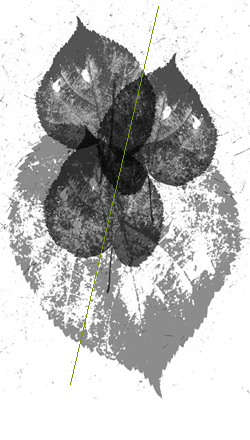Mantra, for gamelan and sinfonietta
My piece Mantra, for gamelan and sinfonietta, was released by BIS Records in October 2018!
 Recorded by Trondheim Sinfonietta at Kimen Kulturhus (Stjørdal, Norway)
Recorded by Trondheim Sinfonietta at Kimen Kulturhus (Stjørdal, Norway)
Kai Grinde Myrann, conductor
Espen Aalberg, gamelan
I am very pleased to share Trondheim Sinfonietta’s 20th-anniversary album with three fine composers: Toshio Hosohawa, Bent Sørensen and Kristin Norderval.
Mantra was commissioned by Espen Aalberg, and funded by Arts Council Norway (Norsk Kulturråd). This album is supported by The Norwegian Society of Composers, the Fund for Performing Musicians (FFUK) and Kimen Kulturhus.
‘Recommended’ by MusicWeb International:
“Seemingly disparate works, all enjoyable, but Lindquist’s gamelan concerto is a revelation.”
“…While all of these pieces demonstrate their composers’ capacity for imaginative instrumental colours and deserve focused, concentrated listening, I have to say that I found Ellen Lindquist’s gamelan concerto Mantra to be one of those rare experiences which offered something completely different; music of integrity and humility yet rich in adventure and daring in its ambition. In this magnificent performance by these Norwegian musicians, and in superb BIS surround sound, it completely blew me away.”
—Richard Hanlon (read full review)
CD Review from Expresso (Portugal’s leading weekly newspaper):
“…Ellen Lindquist’s “Mantra” feels practically restorative: scored for gamelan, and thirteen exquisitely (re)tuned instruments, the work is a marvelous showcase of ingenuity and sensitivity, without any superfluous bric-a-brac and cheap, thrift store chinoiserie. It has a very charming, ecumenical innocence and the sort of spontaneity someone like Steiner would refer to as extraterritorial – built with concentric, ethereal patterns, albeit spectacularly telluric, a geologist would describe it as a beautiful Liesegang ring made of soluble salts. Actually, it sounds as the very salt of life.” (translated from the Portuguese)
—João Santos
Here is a short film about the project made by Alice Winnberg, followed by a short documentary made for NTNU Institute for Music by Martin Kristoffersen:
https://musikk.hf.ntnu.no/2018/10/05/dokumentar-om-mantra/
Program Notes (by Nick Breckenfield, from BIS CD booklet):
Mantra has a title that in itself indicates its eastern
inspiration, specifically the unique sound-world of Indonesia’s gamelan orchestra,
with its constituent parts of not only a series of distinctive chiming instruments
(metallophones, xylophones, gongs etc.), but also bowed, plucked instruments and
drums, which dates back to the Indonesian Majapahit Empire (1293–c. 1500).
Anyone who has experienced a traditional all-night Indonesian shadow-puppet
show, a wayang kulit, will testify to the mesmeric quality of the repetitive music.
Mantra (2016) was jointly commissioned by the performers on this world pre –
mière recording, the percussionist and gamelan player Espen Aalberg and the
Trondheim Sinfonietta, with support from Arts Council Norway. It was first per –
formed at the Trondheim Open festival on 11th November 2016. Having made par –
ticular study of the overtone sequences of the Indonesian instru ments, Lindquist
has retuned the Sinfonietta’s instruments to chime (forgive the pun) with those of
the gamelan. Over an extended soundscape and at an almost-exclusively slow
tempo, Mantra subtly revels in ever-changing intonation, con juring almost a fourth
dimension that seems to stretch back in time.
Lindquist explains: ‘In traditional Indonesian gamelan music, it was believed
that the soul of the entire gamelan was found in the gong ageng, the lowest (and
usually largest) of the hanging gongs, which was said to be used to summon the
gods. More complex messages could be sent with the gamelan’s other hanging
gongs. Mantra was inspired by this concept, and the piece was built using spectral
analysis of the six large hanging gongs in the instrument collection. The soloist in
Mantra plays many different gamelan instruments, and some material for the piece
was developed in an improvisation-based process.
‘The word mantra comes originally from Sanskrit; a simple idea (a word, sound
or phrase) repeated over and over, used to enter a meditative state, the very repeti –
tion aiding concentration. In Mantra this concept exists fractally on several different
overlapping layers of time, manifesting as everything from a single event, to a short
phrase, to the solo gong melody stretched over the length of the piece.’
Lindquist’s score looks deceptively standard: single winds – although unusually
it is the low wind instruments (cor anglais, bass clarinet and double bassoon) that
join the flute – with horn, trumpet, trombone, harp and strings, in addition to the
gamelan player. Despite the visual cornucopia of actual instruments, the gamelan
is notated often on a single stave, occasionally two, with a written indication as to
which instrument – gangsa, Balinese reyong, Javanese reyong, siter, gong ageng
etc. – while the ensemble’s instrumental parts are suffused with pitch instructions
to match the gamelan.
As indicated by the devotional title, this is a 25-minute reverential hymn full of
subtle teeming detail and delicate instrumental partnerships, set off by the harp and
gamelan, out of which develops an important recurring quaver motif, beginning
and ending with a dotted quaver, as if the repeated mantra of the title. The medi –
tation is glacially slow, but more important is the opening instruction: ‘Still, ex –
pectant,’ as if the message is that we need to give ourselves the occasional elongated
time span to think calmly. The interaction between eastern and western instruments,
both unusual and also timeless, encourages us to do just that: to breathe deeply and
lose ourselves in an other-worldly soundscape to assuage the travails of the modern
world.
